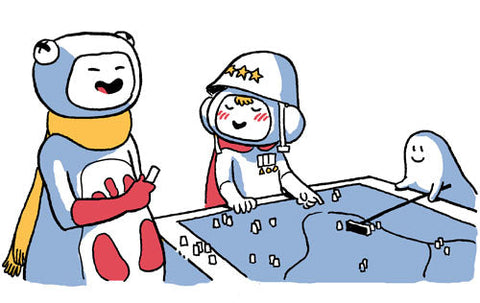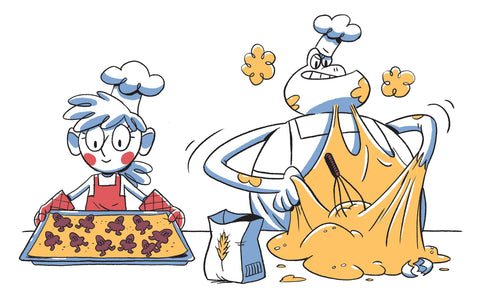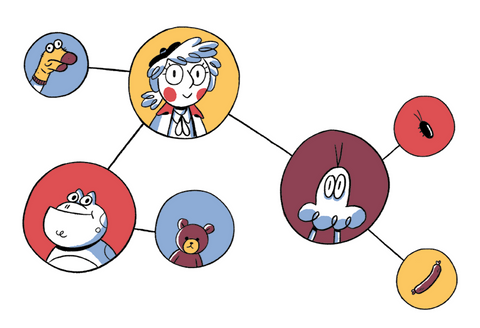During this session we were joined by Ben Mosior, who walked us through the benefits of Wardley Mapping and how to create our own.
Ben is also working with David Holl to create the Strategy Tactics Pip Deck
Strategies: what are they and are we utilising them effectively?
What do we think of when we hear the word “strategy”?
- What isn’t now that needs to change
- An explicit plan to get from one point to another
- A strategy is not only what you decide to do, but what you decide not to do
- A board game
- Strategy is more about your destination and involves your whole team. A plan is step-by-step instructions to execute the strategy
- Strategy can be used to test a hypothesis
- Strategies are interchangeable
- Plan or tactic
- Doing things on purpose
Do you think people have a similar thing in mind when they hear the word “strategy”?
No. Everyone has a different perspective on what a strategy is and what it should look it. People sometimes get confused between a plan and a strategy. You can know a strategy, but if you can’t communicate it or share it, it will cause problems.
When do you typically hear the word strategy?
- Business
- Management
Are strategies only applicable to business?
No, they are used everywhere with anything that needs to be done. The more complex something is, the more likely you would need a strategy.
How You Are Doing Strategy Wrong
Most meetings are terrible.
How do we know when a meeting has been bad?
- It was unfocused
- Finishes with no actionable outcomes
- Take up time and nothing comes from it
- No culture around a meeting (no real organisation and involves participants that aren’t essential to topic)
- Very few people include a facilitator in the meeting so no one is there to take full control
“A good meeting happens when it has purpose”
There are a lot of reasons why meetings can go wrong. Bringing thought to these reasons can make your meetings better.
Ben’s 3 main reasons why meetings turn bad:
1. Selfishness
Picture this: during your meeting, everyone is talking AT each other and the only reason someone is listening is because they are waiting to talk. OR, people talk past each other. When listening, they are hearing the words but not doing the work to understand what they’re saying.
Sometimes, people attend a meeting with their own agenda rather than focusing on collaboration around one specific issue.
When a lot of people are talking at once, it can create a false consensus; they think they’re having a productive meeting but no shared understanding is actually happening.
In some scenarios, you may not feel like you can ask for clarification in fear of looking like you don’t understand.
A tip to avoid this happening is to sit back, pay attention and then you can make intentional choices. This takes a lot of work but people that listen carefully usually pick up on things that others wouldn’t.
2. Nonsense or “Blah” words
These are words that have lost their real meaning and are thrown into meetings to make it sound productive or person more authoritative.
Examples of “blah” words are:
- Transformation
- Strategy
- Mapping
- Alignment
- Agile / agility
- Key learnings / takeaways
These words lose their meaning unless they have purpose behind them.
3. Wishful Thinking
Often, meetings tend to avoid finding out the real truth behind the product or service because it can cause anxiety or fear. When you hide from this ignorance you tend to plan according to your desires (what we WANT to be true) rather than your realities (what is ACTUALLY true).
Implications of wishful thinking are:
- Unforced errors and making mistakes you don’t need to make
- Miss easy opportunities and make things harder than they need to be
Roadmaps
A “roadmap” embodies all 3 points quite neatly. It is essentially a selfish plan that is filled with wishful thinking/nonsense.
SO, what do we do instead?!
We use Wardley Mapping.
Exercise
Understanding the Map
- At the top: citizens, users or people that have needs – the ones we are designing our organisation and market systems to serve
- This example system produces a benefit of helping citizens stay informed. This is their need.
- Citizens can stay informed by getting information from influencers, traditional news media, social media etc.
Citizen (who is being served) > stay informed (their need) > influencers, traditional news media, social media etc. (chain of dependencies to enable this system to function).
The words along the bottom describe the evolution and give us labels to use to plot our dependencies. The map should be read from left to right and show a progression or evolution of your system.
The red arrow is an annotation showing us what we think ought to happen.
Value Chain: a chain of dependant parts in a system that produces a value or benefit for the user. When you add evolution to your value chain, this makes a Wardley Map.
Why you should use Wardley Mapping
- This method can move from selfishness/nonsense to collaboration
- Because you will talk through a shared model, sketch or artefact, you will be co-creating
- You can apply the “blah” words with purpose
- You can seek out the ignorance and fix it together
-
You will nail opportunities and approach other opportunities with nuance
How To Create your own Wardley Map
Tip: Before you start, get yourself something to sketch with.
Step 1: Choose a situation or problem that you are currently dealing with.
(Wardley Mapping works for professional and personal problems, so you can choose anything!)
Step 2: Decide who will benefit from the system that you are creating – this is your ‘user’
Step 3: What is the overall benefit of the system? This is your ‘user need’
Step 4: Write down 3-5 capabilities that can be used to create or fulfil the user need.
To help you decide on your capabilities, think of them as parts of a machine. The overall machine is what will help you overcome the problem, but the machine wouldn’t work without it’s parts. Your capabilities are the parts of the machine that is going to help you solve your problem.
What do I do if I have more than 5 capabilities?
Pick 3-5 from your list at random OR choose the ones that interest you the most. Picking only 3-5 stops you from being overwhelmed by the process.
Step 5: Draw a regular table and split it in to 4 sections - label the sections 1, 2, 3 & 4. This your blank map.
Step 6: Write your ‘user’ at the top of your table. Then, plot the ‘user need’ and your ‘capabilities’ on to your map using the below table:
What happens if you are using Wardley Mapping for a personal problem? Do things in our lives still follow the stages of capitalism?
Yes. For example, if you have open-mindedness on your list of capabilities - is open-mindedness a novel idea or is it universally accepted? Or is it somewhere in between? If you can apply it in this way, you can assume it has been influenced by capitalism.
Tips & Useful Prompts
- Start by plotting your ‘user need’ using the Market Action row towards the bottom of the table
- Don’t obsess over where things go, it’s ok to be wrong and you can learn a lot from those mistakes
- If you’re struggling, pay attention to the dark grey options at the top of the table
- Give yourself permission to trust your gut
- If a capability sits between 2 areas you can plot it in between them
- See the map as more of a gradient rather than a set path
- If you have some abstract capabilities, try focusing on the practice and knowledge stages of evolution
- Always think about where the capabilities sit within context to your problem
- If you want something to succeed e.g. a new invention, meditation etc. you WANT it to be in genesis because that is the only way it can starting moving through the evolution
- Paying attention to stuff, can be totally ground breaking
- Where do you start with maps? Have a tendency to make the map as close to reality as possible. But thinking about ‘where does it hurt?’ and then using that as a starting point?
The subject of Bias
If you can have an open discussion about an artefact then you can clear up some bias.
Step 7: “Sit with your map”
Sitting with your map is a practice where you bring yourself thoughtfully to what you have created. Give yourself 5 minutes to look at each part of your map and capability whilst asking yourself the questions in the table below.
Whilst sitting with your map, list the questions and comments that come to mind.
What happens if all of your capabilities are personal? How do you evaluate them?
There are ways to find the answers to these questions, whether they are through a therapist or a friend/family member/blog post.
Toxicity
By having this capability in our organisation, we are draining our limited resources, time and attention. This is harming us.
Q&A with Ben
Q: Is the goal to move towards commoditisation?
A: Yes, we want to move the dependencies to the right of the chart along the evolution because that is what will improve it’s qualities. There’s more money to be made in the stage 3 area because you’ll have a predictable margin.
Q: What are your thoughts on things in your map needing to connect?
A: Modelling your maps are a skill and people can get stuck on that part of it. You can’t include everything.
Q: When making a Wardley map, should you focus on one specific product or everything as a whole?
A: By creating a map, we are gaining an understanding of what is working and what is not working. If you are in a hierarchical organisations, Wardley Mapping is still a great tool to have. You can cultivate power as an individual by knowing how to create a Wardley Map. To use this power, bring one person along for the journey and discuss the things you have found from your Wardley map - this is collaborating with purpose.
Q: Wardley Mapping is a diagnostic tool but do you also see it as a way of designing a ‘what might be’ or testing a hypothesis?
A: Yes. You can do a what was vs. what is. You can also use it as a futuring exercise, for example, you can look at your current reality, forecast how a problem is going to play out and then re-design your ideal present that will solve your current problems, avoid the terrible future and start paving the way to your ideal future.
Extra Reading & Resources
- Example Wardley Map
- The Evolution Table
- "Where are the obvious opportunities" Table
- Stanford University Study: ‘The Curse Of Knowledge’
- Made to Stick: Why Some Ideas Survive and Others Die by Chip Heath & Dan Heath
- Rich Pictures, a visual alternative to a Wardley Mapping
- Nobody Cares About Your Precious Framework
Contact Ben
Email: ben@hiredthought.com
Twitter: @hiredthought
Website: learnwardleymapping.com
Ben is also working with David Holl to create the Strategy Tactics Pip Deck











